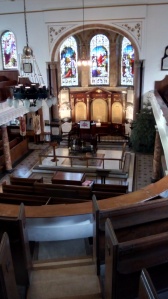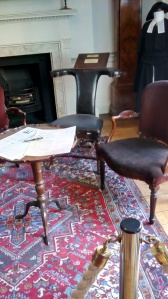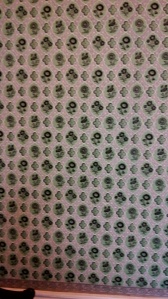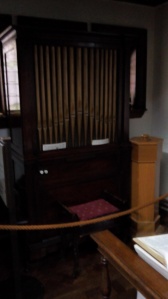On 6th January I set out on the 9.34 train to Waterloo and made my way from there by tube to Old Street. On the tube train I found a purse that someone had left behind, so I handed it in at Old Street station and then tweeted the name on the debit card it contained, in the hope of reuniting it with its owner. It felt good to be doing a small act of kindness on the way to the chapel of one of the kindest men this nation has known.

The day was cold and I was chilled through when I arrived, so I sat in a pew next to a radiator and looked up at the pulpit from which, according to information I later found in the museum, Wesley himself had preached. The building itself is very beautiful with marble pillars, ornate carvings, stunning stained glass windows and elaborate gold decorations on the white walls and ceiling. The Methodist chapels I visited in childhood, such as the one where my grandfather was the minister, were marked by their plain simplicity, and I was not expecting quite such a contrast.

As I sat facing the pulpit and taking in the sight and atmosphere, male voices suddenly broke into a rendition of Charles Wesley’s hymn, “Come, Thou long-expected Jesus, born to set Thy people free”. They were in the balcony above and behind me, out of my sight, and it felt as if an angel choir had gathered to remind me of my purpose in being here – the pursuit of Jesus and establishing a deeper walk with Him.
There was plenty to see and do, but I felt like a worshipper, not a tourist and I just wanted to sit for a while and soak up the atmosphere, worship God, and bring my prayers to Him. I told Him I was here because I wanted to put a stop to the gradual drift away from Him that had been going on for some time now, and for 2017 to be a year of drawing near again. It was lovely to have a leisurely day when I could take all the time I needed to be in His presence and be present to Him.
I walked around the perimeter of the chapel, looking at the detail of each stained glass window and reading all the In Memoriam inscriptions. I was surprised to find a window sponsored by Methodist Freemasons, having always believed Christianity and Freemasonry to be incompatible. But how sad that, by the end of the day I had found seventy-eight memorial plaques and windows, but only seven of these mentioned women, and three of those only as a footnote to their husbands’ inscriptions. Considering how much the advancement of the kingdom of God in this country owes to many generations of the women of the Methodist movement, women like my grandmother, a Methodist minister’s wife who devoted her life to prayer, ministry, hymn writing and acts of kindness, I wondered if their contribution is really as little esteemed as this might suggest.
I was then invited to join a tour of the house where John Wesley lived and died (though in life he was, of course often away from it – he rode a total of a quarter of a million miles on horseback the length and breadth of this nation to preach the Gospel). I saw his Christening robe, clerical garb and shoes and was surprised at how small he must have been. There was also a rattle he played with as a baby, and a Wedgwood teapot with two prayers written on it. But, unknown to Josiah Wedgwood when he made the gift, John Wesley did not approve of tea drinking, and it would probably only have been used for home-made herb teas, made from garden herbs such as sage.
I was fascinated by the writing case he took with him to write his thousands of sermons and hymns while on horseback. It was quite compact and would fit comfortably in front of him, with a sturdy, level surface on which to write. His travelling chest was surprisingly small – clearly he travelled very light.

Some of the objects in the house gave a feeling of real connection with the man – the kitchen table and dresser were the ones used here in his time. There was a leather chamber horse (a replica of his own), to be bounced up and down on for twenty minutes a day when the weather was too inclement to go horse riding out of doors! At some time in the past many layers of wallpaper had been peeled off the walls until the final layer, Wesley’s own wallpaper, was reached. Exact replicas were then made for each of the rooms, so they are now decorated exactly as in his time.

This part of my visit felt more touristy – I felt the same frisson when I saw his study with its writing table as I feel whenever I visit Jane Austen’s house and see her writing table (the two being very similar in size and shape).
I saw his study with its writing table as I feel whenever I visit Jane Austen’s house and see her writing table (the two being very similar in size and shape).
 But the spiritual intent of my visit rushed back over me when I stepped into his prayer room and saw the low dresser with a big Bible spread on it and the little kneeler before it – no chair to sit in here; this was a room for knee-work. The sense of God’s presence was palpable, as if the walls were saturated with the many, many prayers that had gone up from this room.
But the spiritual intent of my visit rushed back over me when I stepped into his prayer room and saw the low dresser with a big Bible spread on it and the little kneeler before it – no chair to sit in here; this was a room for knee-work. The sense of God’s presence was palpable, as if the walls were saturated with the many, many prayers that had gone up from this room.
After leaving the house I visited the original Foundery chapel where I was happy to find the lectern Bible open at the very chapter I had read before leaving home that morning. I was delighted also to see Charles Wesley’s own pipe organ.


The guide who showed us round the house had told us that Charles Wesley frequently rode on horseback to his brother’s house, and on arrival would often dismount and rush into the house calling for a quill pen to be brought quickly so that he could write down some hymn verses that had come to him on the way, before he forgot them. That called forth a wave of empathy from me – how often I have done the same sort of thing (not that I put my writing on a par with his!)
The museum filled in some details that the guide had not mentioned. John Wesley died with friends and family around his bed, and his last words were, “The best of all is, God is with us.” As well as centuries-old documents and artefacts, there were a number of i-pads in the museum to enable an interactive experience. You could select a hymn to listen to, and I chose the one that caught my eye and seemed to sum up the purpose of my journey. I listened to it all the way through before continuing round the museum:
O Thou Who camest from above,
The pure celestial fire to impart,
Kindle a flame of sacred love
On the mean altar of my heart.
There let it for Thy glory burn
With inextinguishable blaze,
And trembling to its source return,
In humble prayer and fervent praise.
Jesus, confirm my heart’s desire
To work and speak and think for Thee;
Still let me guard the holy fire,
And still stir up Thy gift in me.
Ready for all Thy perfect will,
My acts of faith and love repeat,
‘Til death Thy endless mercies seal,
And make my sacrifice complete.
But the real treasure which I discovered was the covenant which Methodists say once a year. I brought home a copy of it, and I intend to make it my prayer every morning for the foreseeable future:

The words made me think of Jesus, who emptied Himself for our fullness, and of Paul’s words about “having nothing, yet possessing all things”. With much to ponder on and much to aspire to, I returned to the chapel to spend some more time in silent contemplation. As I sat down in the pew, a pianist began to play “It is well with my soul” – which seemed a fitting end to my visit. I loved how my time in the chapel had begun and ended with hearing worship in song.
